Figure 11.
Symbiotic Phenotype of M. truncatula Plants Expressing MtNFH1 Driven by a Tandem CaMV 35S Promoter.
M. truncatula R108 plants were stably transformed with A. tumefaciens carrying pISV-MtNFH1. The symbiotic phenotype of two transgenic lines with increased NF-cleaving activity was compared with wild-type plants.
(A) Hydrolysis of NFs by intact roots of M. truncatula lines constitutively expressing MtNFH1. Roots of seedlings from wild-type R108 plants and four independent lines constitutively expressing MtNFH1 driven by a tandem CaMV 35S promoter (named L1 to L4; T4 generation) were first individually pretreated with 0.1 μM NodSm-IV(C16:2, S) for 24 h and then incubated with 15 μM NodSm-IV(C16:2, S) for 18 h. Formation of NodSm-II(C16:2) was analyzed by reverse-phase HPLC (1 plant per sample). Data indicate means ± se. In total, 36 transgenic and nine wild-type plants were analyzed. Hydrolysis of NFs by the four lines was significantly elevated compared with wild-type plants (Kruskal-Wallis test; P < 0.05; Supplemental File 1).
(B) Analysis of early symbiotic stages in wild-type, L3, and L4 lines inoculated with S. meliloti 2011 carrying pXLGD4 (lacZ). Roots were harvested at 7 dpi and stained with X-Gal to visualize bacteria. Data indicate means (±se) for 14 plants per genotype. Significant differences between the L3 or L4 lines and wild-type plants are marked with asterisks (Kruskal-Wallis test, P ≤ 0.05; Supplemental File 1). IF, infection foci; eIT, elongating infection thread in root hair; IT, fully elongated infection thread in root hair; bIT, branched infection thread in cortex; NP, nodule primordium.
(C) Photograph of an abnormal root hair of L4 showing tip swelling induced by S. meliloti 2011 carrying pXLGD4 (3 dpi). Bar = 20 μm.
(D) to (F) Photographs of nodules induced by S. meliloti Rm41 harvested at 20 dpi. Wild-type plants (D) formed elongate nodules while the L3 (E) and L4 (F) lines formed bifurcate or palmate-coralloid nodules. Bars = 2 mm.
(G) Quantification of different types of nodules formed by wild-type, L3, and L4 plants. Data indicate means values (±se) from 10 plants per genotype. The number of nodules formed on L3 or L4 roots was significantly lower than on wild-type roots (differences marked by asterisks; Kruskal-Wallis test, P ≤ 0.05; Supplemental File 1).

